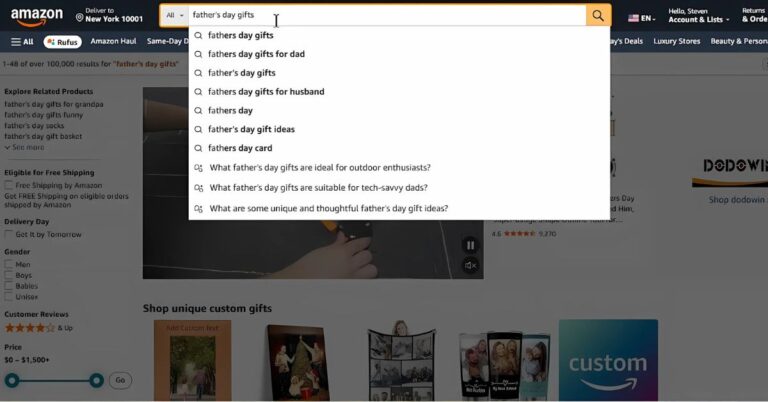
A recent A/B test confirms a new Amazon search trends shift, where a hybrid approach using LLMs to power search suggestions led to a measurable 0.13% lift in sales revenue.
For years, Amazon’s search bar has operated on a simple principle: popularity. This system excels at suggesting common items but struggles to introduce shoppers to new, innovative, or more relevant products.
This limitation creates a frustrating experience for shoppers who can’t find what they need and stifles growth for any Amazon seller whose products don’t fit into narrow, high-volume search terms. The result is a stagnant discovery process where the rich get richer.
Now, an Amazon search trends shift is underway to break this cycle.
The platform is using sophisticated LLMs to understand the nuances of language and intent, moving beyond simple popularity. The potential is enormous, as other retailers using LLM-powered personalization have boosted revenue by 10-30%, proving the value of a smarter search experience.
The technology driving the search shift
Amazon Science recently published a research article by Sonali Singh, Sachin Farfade, and Prakash Mandayam Comar that explores the limitations of traditional Query Auto-completion (QAC) and evaluates a new model powered by Large Language Models (LLMs). The study analyzes how current systems that rely heavily on past user interactions fall short in surfacing new and diverse suggestions for a product on Amazon.
Traditional QAC is designed to prioritize query relevance using search logs from historical user behavior. While this helps highlight commonly searched terms, it often misses new product launches and emerging trends, creating a gap in discoverability.
To address this, researchers compared existing state-of-the-art (SOTA) QAC systems with LLM-based approaches that understand language context and catalog information. The LLM-driven method delivered a 38% improvement in suggestion diversity without impacting relevance scores.
Despite their effectiveness, LLMs are resource-intensive, posing challenges for real-time performance and large-scale deployment. The study proposes a hybrid heuristic method that combines traditional QAC strengths with the broader capabilities of LLMs.
Key findings from live A/B testing include:
A 0.13% increase in sales revenue using the hybrid LLM + heuristic model
Enhanced discovery of less-searched and newly launched products
Maintained latency and relevance performance close to current standards
The study highlights a measurable shift in how Amazon adapts its search infrastructure to better support evolving product trends and user intent. This change not only improves the shopping experience but also presents new opportunities for sellers whose products may not rank under legacy systems.
Straits Research"As industries seek greater operational efficiency and cost savings, the adoption of LLM-driven automation tools is expected to surge, solidifying their role as indispensable assets in digital transformation initiatives."
Adapt your listings to this Amazon Search Trends Shift
As Amazon updates its search auto-complete system using Large Language Models (LLMs), sellers need to rethink how their listings are structured. Kevin King recently featured this shift in his LinkedIn newsletter, highlighting how it changes product visibility and offering key tips for sellers to stay competitive.
The LLM-powered search now recognizes a broader set of terms, generating suggestions beyond common high-volume queries. This means even products with fewer sales or newer listings have a better shot at being discovered—if the content is optimized correctly.
To increase the chances of your product appearing in auto-complete suggestions, sellers should:
Use Specific, Keyword-Rich Titles
Instead of vague phrases, include product details that match real shopper queries. For example, “Indoor Outdoor TPE Yoga Mat with Carrying Strap – 6mm Extra Thick, Non-Slip for Pilates” covers more relevant search paths than “Thick Yoga Mat.”
While optimizing titles for keywords remains critical, sellers should not forget a relevant policy update that Steven Pope, our Amazon agency founder, featured in the video below.
The “two-part title” system is a potential change that would split titles into a short, prominent section (likely around 50 characters) for core information and a longer “product highlight” section (around 150 characters) for details.
Although this could fundamentally alter how titles are displayed and weighted, experts strongly advise waiting for official implementation before making any changes, as the final rules are still in development.
Add Keyword Variety in Bullet Points and Descriptions
Auto-complete now favors listings that include related terms across multiple use cases. A turmeric supplement listing should include keywords like “joint support,” “anti-inflammatory,” and “curcumin with black pepper.”
Use Customer Language, Not Just Marketing Jargon
LLMs understand how real people search. Replace technical terms with natural phrases, such as “cooking pot with lid for pasta and soup” instead of “multi-purpose culinary pot.”
Target Long-Tail Keywords in Backend Search Terms
LLMs respond well to full, specific phrases. Use search terms like “non-slip yoga mat for tall beginners” or “dog shampoo for itchy sensitive skin” to appear in relevant long-tail queries.
Update Listings to Reflect What’s Trending
Auto-complete updates quickly, mentioning timely features can make a difference. For example, if “wireless charging” or “MagSafe compatible” are trending, a phone case listing should include: “Slim, MagSafe-compatible phone case with wireless charging support.”
The shift also changes how suggestions appear during live searches. A user typing “vitamin c ser…” might now see suggestions like “vitamin c serum for hyperpigmentation” or “anti-aging vitamin c serum.” Listings that include these phrases are more likely to surface, even if they aren’t top sellers yet.
LLMs reshaping ecommerce beyond the search bar
The technology driving the Amazon search trends shift has other powerful uses in e-commerce. As written by Kacper Rafalski in Netguru, Large Language Models are being applied across the entire retail ecosystem to enhance both the customer experience and business operations.
LLMs enable a more precise and intuitive product search that goes beyond simple keyword matching. This technology can comprehend detailed queries and grasp semantic meaning, allowing it to understand synonyms and context to return more relevant results.
Other Notable Uses of LLMs in E-commerce Include:
Precision Product Search
Understanding queries from general (“men’s running shoes”) to highly specific (“women’s hiking boots size 8”) by decoding intent.
Recall Product Search
Matching meaning through synonyms, spelling corrections, and relaxed search rules.
Conversational Chatbots for Product Selection
Helping customers compare and choose products in a natural dialogue.
Chatbots for Pre-Purchase Questions
Offering fast, always-on answers to common buyer inquiries.
Chatbots for Checkout Support
Reducing friction at checkout to lower cart abandonment.
Post-Purchase Chatbots
Managing delivery updates, returns, and support tickets.
Abandoned Cart Chatbots
Proactively nudging customers to finish their purchases.
Personalized Product Recommendations
Analyzing behavior and context to suggest the most relevant items.
Dynamic Pricing Engines
Adjusting prices based on inventory, demand, and competitor activity.
Fraud Prevention
Detecting anomalies in real-time transactions to flag potential fraud.
Automated Descriptions
Writing SEO-optimized copy at scale based on product data.
Customer Feedback Analysis
Extracting insights from reviews and messages to inform strategy.
Visual Search Feature
Letting customers upload images to find visually similar products.
Voice Shopping Assistants
Allowing search, cart updates, and checkout through spoken commands.
Post-Purchase Retargeting
Sending follow-ups based on behavior to drive repeat purchases.
Inventory Forecasting
Using historical trends and real-time signals to accurately predict stock needs.






